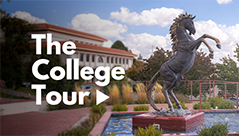Like many student organizations, the Native American Student Alliance (NASA) lost momentum during the COVID-19 pandemic. A new group of students, however, have re-chartered the organization and are already knee-deep in coordinating this year’s activities, according to NASA President and graduate student in Early Childhood Education, Rebekah Stevens (Choctaw).
The signature event for the fall semester was Native American Day, held on November 15. NASA worked with dining hall staff to coordinate a lunch of traditional indigenous foods based on recipes provided by NASA students. The day also included a screening of the award-winning film “Smoke Signals.”
The highlight of Native American Day was a forum on “Navigating Native American Culture Today.” The panelists for the forum included Dr. Perry James (Navajo), WNMU Adjunct Faculty; Bill Bradford, Chiricahua Apache Nation Attorney General; and Joe Saenz, Chiricahua Apache Nation President. The forum was moderated by NASA officers Stevens and Anais Orantez, with assistance by NASA faculty advisor Professor Scott Fritz.
The event was just the latest in a schedule of activities sponsored by NASA. “We have had a lot of events since we re-chartered,” said Stevens, “We have really tried to hit the ground running.” Last year, the group created a display case for Miller Library, and this year they plan to add to it by including tribal flags from all of the nations represented by Native American students at WNMU.
Beyond this project, said Stevens, NASA’s other goals include both physical and demographic change. “We would like to revitalize the building we share with MEChA,” noted Stevens. She is also interested in helping to grow the university’s Native American student population. “I think our online education programs and social work programs are especially attractive to Natives,” she said, “They are accessible, and I think there is a lot of need. So I hope to work more with faculty . . . just to grow the Indigenous presence at WNMU.”
Stevens and her fellow NASA members have already had opportunities to help with recruitment, especially when Mescalero Apache middle school students have visited the WNMU campus as part of their annual harvesting of agave to be used for ceremonial purposes. “We have opportunities during the agave harvesting that happens in the spring,” said Stevens, “For two years in a row, I have been able to participate in welcoming them, and I hope that those middle schoolers will consider coming here eventually because [WNMU] is a friendly institution for Native students.”
Another goal of the organization is to continue to grow. One way that NASA is fostering more student involvement is by continuing the pandemic-era tradition of digitally streaming events. “We have kept everything both online and in-person because that is the world we are in right now,” Stevens indicated, “We try to keep things so that digital students can be involved.”
Stevens said she hopes to see NASA expand not only to include more students but also to continue to sponsor activities for the broader community. “I think a lot of community support is important,” she said, “and we welcome the community to come to meetings and be involved.”


